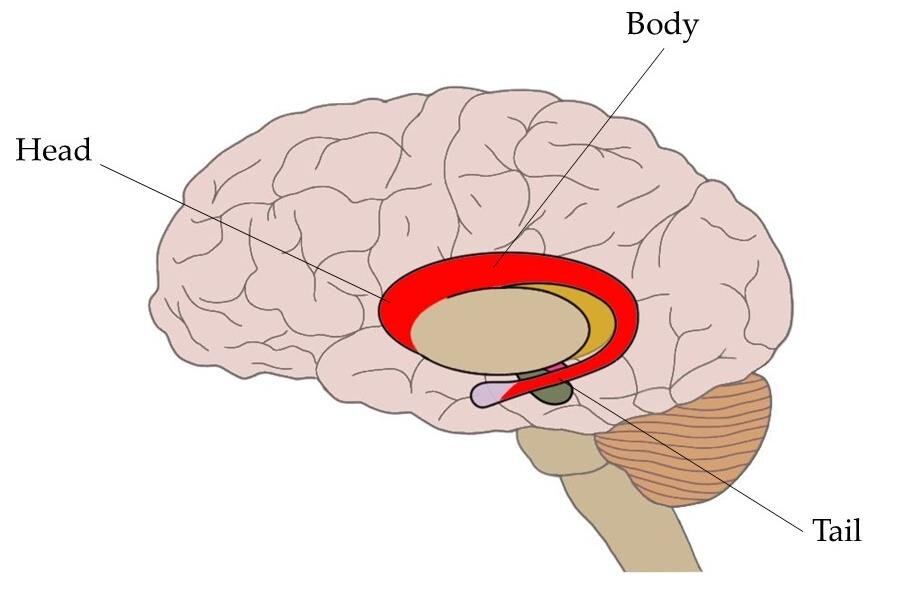Know Your Brain: Caudate Nucleus
Where is the caudate nucleus?

The caudate nuclei (there are two—one on each side of the brain) can be found below the cerebral cortex, situated next to the lateral ventricles. Like the lateral ventricles, the caudate is a C-shaped structure with a thick anterior portion called the head, which becomes narrower as it extends towards the back of the brain. The middle portion of the caudate is known as the body, and this tapers off into the tail of the caudate.
The caudate is situated next to the putamen, and is linked to the putamen by “bridges” of grey matter, which cause the connection between the two structures to take on a striped appearance. Because of this, the caudate and putamen—along with the nucleus accumbens, which is adjacent to both structures—are collectively referred to as the striatum (“striped” in Latin).
What is the caudate nucleus and what does it do?
The caudate nucleus is considered part of the basal ganglia. The basal ganglia are a group of subcortical nuclei that are involved in a variety of cognitive and emotional functions, but are best known for their role in movement. The contributions of the basal ganglia to movement aren’t completely understood, but one popular hypothesis suggests that the basal ganglia are important for facilitating desired movements while at the same time inhibiting unwanted and/or competing movements. To read more about the basal ganglia and this purported function, see this article.
To accomplish their movement-related functions, the basal ganglia need to receive information from the cortex about movements that you want to make. Most of this incoming information travels first to the caudate or putamen via a pathway called the corticostriatal pathway. The caudate thus acts as one of the main input nuclei for the basal ganglia.
Neurons in the caudate extend to other regions of the basal ganglia— primarily the globus pallidus and, to a lesser degree, the substantia nigra. Most of these neurons contain the neurotransmitter GABA and create pathways that are thought to be involved in either the facilitation or inhibition of movements (depending on the pathway). Research suggests neurons in the caudate are highly active when a movement is initiated. Their activity seems to be especially linked to eye movements, as caudate neurons tend to fire before and during movement of the eyes.
The caudate, however, is also thought to be involved with more than just motor function. For example, neuroimaging studies have suggested the caudate may play a role in goal-directed behavior in general, and specifically with choosing actions that are likely to lead to a positive outcome. The caudate may contribute to a variety of other cognitive functions as well, ranging from habit learning to attention.
Dysfunction in the caudate could be a factor in a number of disorders, but is strongly linked to problems with motor function. Huntington’s disease (HD), for example—which is characterized by rapid, jerky, involuntary movements—is also associated with the degeneration and death of neurons in the caudate and putamen. These neurons may be involved with the inhibition of unwanted movements, and their degeneration may cause involuntary movement to be more difficult to suppress. Additionally, caudate neurodegeneration has been linked to cognitive impairment in HD, like deficits in attention and working memory.
Neurodegeneration in the basal ganglia is also the hallmark pathological sign of Parkinson’s disease (PD), a condition that causes slow, labored movement along with tremors (among other symptoms). With PD, the neurodegeneration occurs primarily in the substantia nigra. Other areas of the basal ganglia are affected in PD as well, however, and it’s thought that neurodegeneration in the caudate may contribute to both motor and cognitive symptoms of PD.
Dysfunction in the caudate has also been linked to a number of other conditions, such as obsessive-compulsive disorder and attention-deficit hyperactivity disorder. But the caudate’s potential contribution to those disorders is still being investigated, as is the full extent of the cognitive functions of the caudate in general. Its movement-related functions are much better understood, but even in that area many details still need to be worked out.
References (in addition to linked text above):
Grahn JA, Parkinson JA, Owen AM. The cognitive functions of the caudate nucleus. Prog Neurobiol. 2008 Nov;86(3):141-55. doi: 10.1016/j.pneurobio.2008.09.004. Epub 2008 Sep 7.
Purves D, Augustine GJ, Fitzpatrick D, Hall WC, Lamantia AS, Mooney RD, Platt ML, White LE, eds. Neuroscience. 6th ed. New York. Sinauer Associates; 2018.


